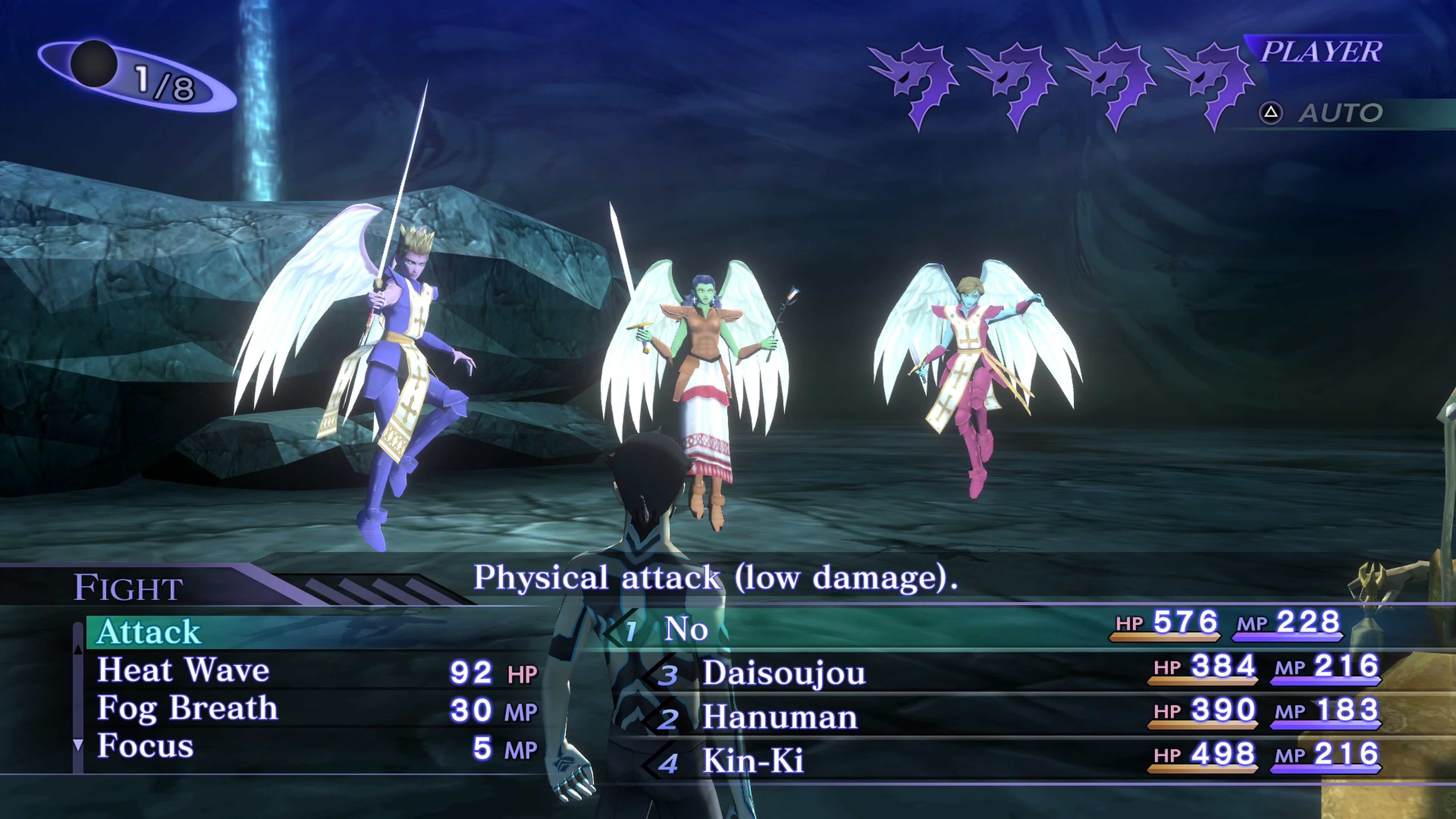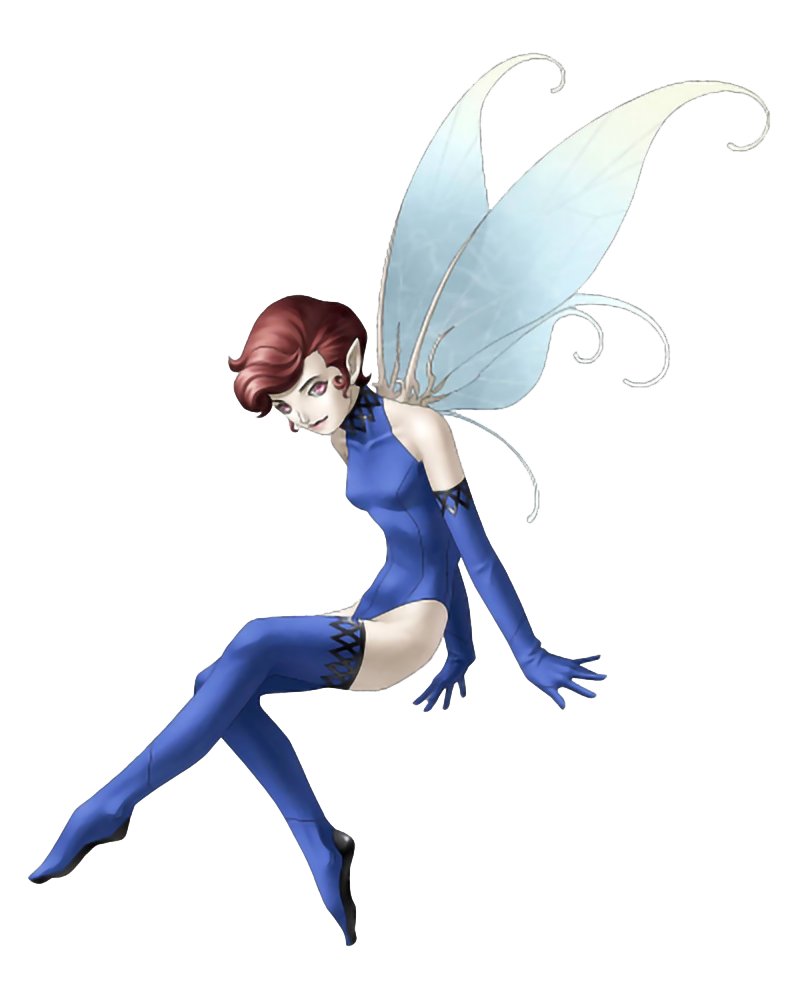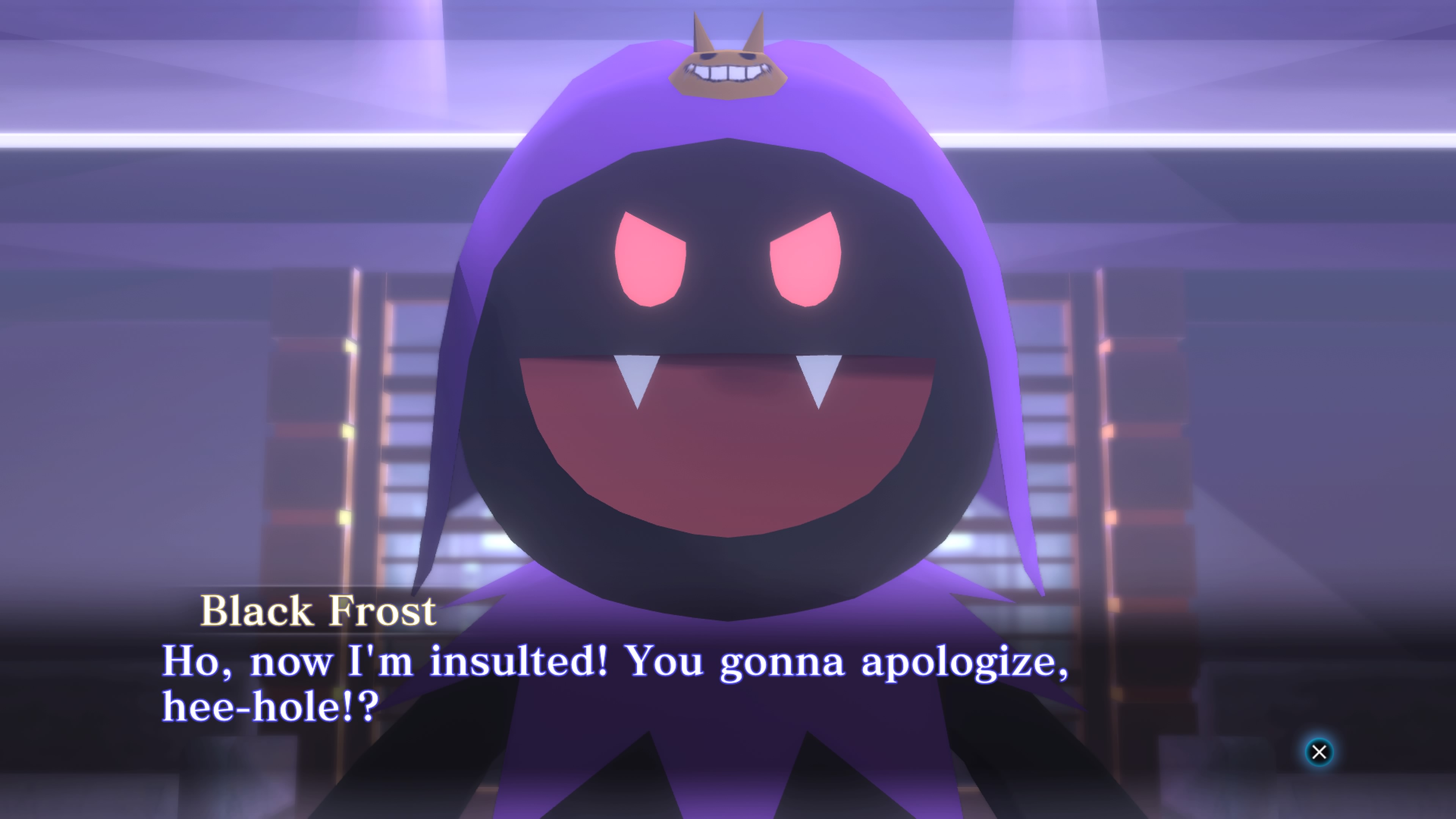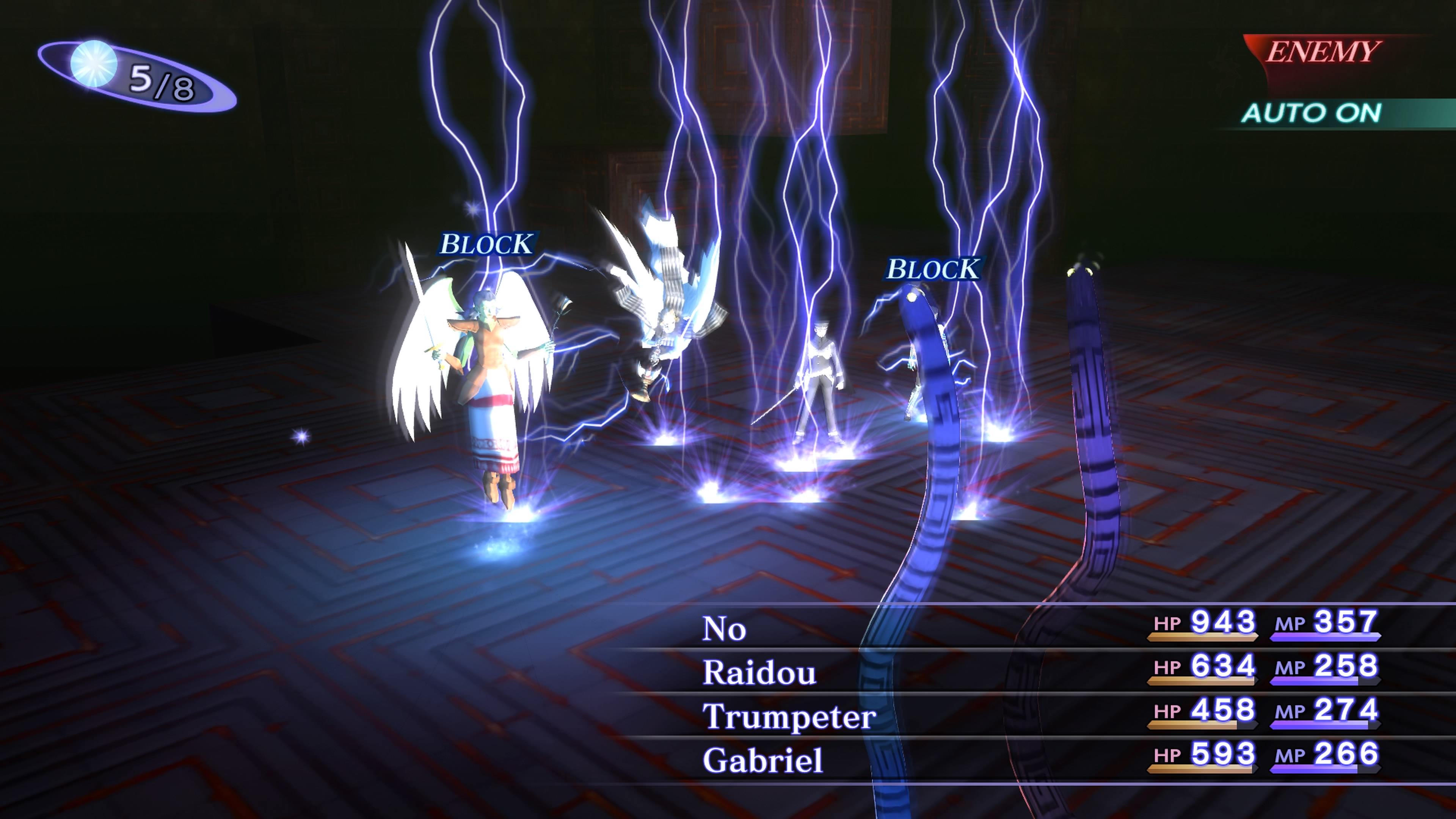
Atlus - Tested on the PlayStation 4 in 2022 by Kaoru
 Shin Megami Tensei III: Nocturne is an interesting game, because it was released three times, yet never left the PS2 (unless PS2 Classics on the PS3's PSN count). It first released in Japan almost ten years after the second game, to revitalize the franchise, but kind of didn't manage to. An expanded re-release, called Nocturne Maniax, should sell better a year later and even got picked up as the first main game to be released in the West! Missing its number in North America and due to licencing issues being renamed Lucifer's Call in Europe. A later release as Nocturne Maniax Chronicles, exclusive to the limited edition of the second Raidou Kuzunoha game, also stayed locked to Japan.
Shin Megami Tensei III: Nocturne is an interesting game, because it was released three times, yet never left the PS2 (unless PS2 Classics on the PS3's PSN count). It first released in Japan almost ten years after the second game, to revitalize the franchise, but kind of didn't manage to. An expanded re-release, called Nocturne Maniax, should sell better a year later and even got picked up as the first main game to be released in the West! Missing its number in North America and due to licencing issues being renamed Lucifer's Call in Europe. A later release as Nocturne Maniax Chronicles, exclusive to the limited edition of the second Raidou Kuzunoha game, also stayed locked to Japan.
So really, if you didn't get that initial release on the PS2 or found it on the PS3's PSN store, you were out of luck. Until now at least. Recently Atlus gave owners oft he PS4, PC and Switch a chance to pick this classic up in the form of a new HD Remaster.
After naming your main character you are set down into modern (well, 2003's modern) day Tokyo. On the way to meet your two friends to see your teacher at the hospital, you'll pick up rumours about demonic cults and all that good stuff. Just to find out your teacher is involved in a scheme to bring the end of the world! Well clearly, was this your usual JRPG, or even the Persona subseries, we would have to stop this. But this is the main SMT series, so the end is inevitable and within fifteen minutes of the game starting, the world as we know it is no more.
 But fret not, you are reborn as the Demifiend, half human half demon. It comes with the benefits of having cool glowing tattoos in the dark and being able to live in this vortex world. A world between worlds, ruled by demons, angels and any mythological being in-between. A world who's sole purpose is for one faction to gather enough energy to bring the rebirth into a new fully formed world of the design of their ambition.
But fret not, you are reborn as the Demifiend, half human half demon. It comes with the benefits of having cool glowing tattoos in the dark and being able to live in this vortex world. A world between worlds, ruled by demons, angels and any mythological being in-between. A world who's sole purpose is for one faction to gather enough energy to bring the rebirth into a new fully formed world of the design of their ambition.
And that's it. That is the whole story so to say. Get to the end to bring in a new world. Simple, right? Nocturne is a bit atypical for a JRPG in that the main narrative is not a big strong thread to follow. The game is a lot more about the journey towards that end than the end in and on itself. Roam the destroyed world and stumble into the bits and pieces of the puzzle, meet other survivors and new rulers. Find out how they cope and what their ambition for the new world is. And at the end you get to decide which of six possible new worlds will be born.
Nocturne is about the immersion into the world, finding interesting titbits and ultimately either a way to follow or your own way in-between. Taking part in this new demonic world and seeing the changed places is super cool, if that is your thing. Beware if you need a strong and more standardised plot with constant human interaction though, because you are not getting that here. The nihilism in Nocturne is strong.
If you think that surviving in a postapocalyptic world full of demons that want you for nothing but your life energy is tough, you might be right. Even though the difficulty of Nocturne is often exaggerated, at least on the normal difficulty setting, it is still by no means an easy game. It gets progressively easier the more you understand its systems though. Which thankfully shouldn't be as hard to most people anymore, because unlike back in 2005, now there are a lot of Megami Tensei games with similar systems you could have already learned from.
 Running into the random battles brings up the Press Turn system. That means every one of your max of four party members gets one turn per round, everyone on the enemy's side gets a turn during their round. Until the point where weaknesses and resistances come in that is. Let's say your enemy is weak to electric attacks and you hit them with one. You get an additional action. Up to eight turns should everyone on your team hit a weakness or critical. On the other hand, should that enemy resist fire attacks and you hit them with one, it eats up an additional action, giving you less to work with on your turn. This also makes Nocturne one of the rare breed of JRPGs where buffs and debuffs are incredible useful. Lower the accuracy of your enemy and/or raise yours and they'll barely ever hit you, wasting additional actions of their round on top of doing no damage.
Running into the random battles brings up the Press Turn system. That means every one of your max of four party members gets one turn per round, everyone on the enemy's side gets a turn during their round. Until the point where weaknesses and resistances come in that is. Let's say your enemy is weak to electric attacks and you hit them with one. You get an additional action. Up to eight turns should everyone on your team hit a weakness or critical. On the other hand, should that enemy resist fire attacks and you hit them with one, it eats up an additional action, giving you less to work with on your turn. This also makes Nocturne one of the rare breed of JRPGs where buffs and debuffs are incredible useful. Lower the accuracy of your enemy and/or raise yours and they'll barely ever hit you, wasting additional actions of their round on top of doing no damage.
All of these are options your enemies have too, of course. Do not be surprised to get an instant Game Over when an enemy pulls out the curse based death attack while your main character is weak to curse attacks. Which is a bit extreme an example, but it does happen. Thankfully Nocturne is most of the times pretty nice with the placement of save terminals, giving you usually one shortly into the dungeon (or right before it) and near one near the boss, even some on the way for the later larger dungeons. Because unless you follow a guide, you naturally do not know what the strengths and weaknesses of the random encounters and bosses of a dungeon are. Meaning you have to experience what they dish out first, before you can tune your team to them.
 Which is another big deal in the systems of Nocturne. It is simply not possible to get through the whole game on the same team. Demifiend is your only constant and human character (and the one who's death means Game Over by the way), the other three slots are filled up with demons. You get them by simply talking to them in battle. As simple as navigating their conversations trees and knowing when to give them gifts is, anyways. So now you have a new possible party member with new skills to bring into battle and possessing new strengths and weaknesses. Or not, if the succubus ran away for the fourth time in a row after asking for all your money. Furthermore, obsolete weak demons do not have to get discarded. In the cathedral of shadows you can fuse two or more demons into new ones that are hopefully stronger and more helpful in the next stretch of the game.
Which is another big deal in the systems of Nocturne. It is simply not possible to get through the whole game on the same team. Demifiend is your only constant and human character (and the one who's death means Game Over by the way), the other three slots are filled up with demons. You get them by simply talking to them in battle. As simple as navigating their conversations trees and knowing when to give them gifts is, anyways. So now you have a new possible party member with new skills to bring into battle and possessing new strengths and weaknesses. Or not, if the succubus ran away for the fourth time in a row after asking for all your money. Furthermore, obsolete weak demons do not have to get discarded. In the cathedral of shadows you can fuse two or more demons into new ones that are hopefully stronger and more helpful in the next stretch of the game.
By no means do you have to literally constantly refuse and re-negotiate your whole team every dungeon, but be aware that is necessary regularly in the game and especially for the harder bosses. At the end of the day it is your own fault to push further into a dungeon full of enemies with fire attacks while half your team is weak to that element. Or trying the boss that lowers your accuracy without a skill to counter that move again. The willingness to put some serious work into re-managing your team should the situation call for it is a necessity to not hate Nocturne.

Now, after saying all of that, I will still admit there are some bullshit moments in Nocturne. Foremost is the rightfully famously awful placement of the Matador fight. He is one of the enemies they added with a new dungeon in the Maniax release. And Atlus really didn't want you to miss that new content, so he appears early on in the game and is a mandatory fight unlike a lot of the other fiend battles. Matador is an absolute asshole who an early team is not ready to fight until some serious fine tuning to him including probably having to grind levels to wield better demons. Another pretty bitchy fight can be the guest character at the Mantra Building a bit later. The game does get better about it after this, though, because you simply have more options in regard of demons at your disposal so you can more quickly and easily change your team to your needs.
But this also gives me an excuse to talk about the changes in the HD Remaster, since that version gives you another way around these too tough fights. That being difficulty settings. While the Maniax version always had them, you were limited to Normal and Hard modes. Now with the HD Remaster comes an additional Mercy difficulty for those not really into the hardcore team building who would rather just experience the world of Nocturne with less road blocks. For some reason you have to download the mode instead of it being automatically included, but it is for free.

Another great change is making said fine-tuning of your team a lot easier by changing one thing during fusions. In the original version when fusing demons, the skills they would inherit from their “parents” were random so you had to reroll a lot if you wanted them to get specific ones and the game was refusing to give it to them. In the HD Remaster you are now allowed to just hand pick what skills they get, making the fusion process much smoother.
The third noticeable change is in the guest character that gets thrown into the world of Nocturne. HD Remaster by default is based on the Chronicles release of the game. Which means that you will meet Raidou Kuzunoha from the PS2 Devil Summoner games with his talking cat. Since that is an Atlus owned character they don't have to pay for to include, the decission makes total sense. If you by all means prefer having Dante from Devil May Cry by your side, like it was in the Maniax and original Western release, that is still an option, but he is paid DLC now.
Nocturne arriving early on the PS2 of course shows its age in some regards. The models aren't as finely detailed as later games and their animations can be stiff. But the game did age a lot better than others of the time thanks to the power of stylisation. Kazuma Kaneko's designs are already pretty non-standard and they put it into cel-shading, looking less realistic and more otherworldly. And the area designs are legit super cool in places. Maybe not when you go through a system of tunnels. But a lot of the demonic hideouts have some incredible interesting architecture. Made out of lit up cubes or all round shapes and such. Thanks to the aesthetic behind it, these dungeons look a lot better than the often simple layouts would make you believe.
 The soundtrack is pretty cool too, from a battle theme that legit barks at you to some epically orchestral tunes when shit really goes down. We all have learned to love Shoji Meguro as the composer behind most games in the franchise since, but in Nocturne he had help by Toshiko Tasaki and Kenichi Tsuchiya which gives the OST more diversity than some more samey sounding ones where only he was the composer.
The soundtrack is pretty cool too, from a battle theme that legit barks at you to some epically orchestral tunes when shit really goes down. We all have learned to love Shoji Meguro as the composer behind most games in the franchise since, but in Nocturne he had help by Toshiko Tasaki and Kenichi Tsuchiya which gives the OST more diversity than some more samey sounding ones where only he was the composer.
The HD Remaster of course adds to this. First of all the game's picture is now a lot clearer having none of the fuzziness of a PS2 game on a CRT tv. As often with these remasters it makes some stuff like the lit lines in the dungeons or Demifiend's tattoos look better, while also showcasing where the original cheated by just putting a wallpaper as a background that the original fuzziness hid. The thing that did annoy me though was the FMVs. Nocturne actually has more than you would think if you only played the PS2 version. Because they are all made with the in game models to make these scenes not stick out from the game flow. They look horrendous in the HD-Remaster, still being clearly 4:3 with borders and super pixelated. Thankfully they are still few and far between.
On the other hand the HD Remaster does include voice acting now, and pretty competent one too. Not all scenes are voiced, of course, but all the important ones with and all the main characters do feature voice over now. Even some more minor ones like the pixie you meet at the beginning of the game to have a demonic companion before the random battles start. As said, the voice acting is pretty good. Personally I would have preferred they not include it if that money could have gone into upscaling the FMVs instead, though.
Rating
| Pro | Contra |
|---|---|
 ·Great and captivating world design
·Great and captivating world design·Cool demon companions to build your team with ·Your decisions matter, leading into several endings |
 ·Some annoying road blocks especially early in the game
·Some annoying road blocks especially early in the game·Not for those wanting a strong narrative ·The HD Remaster is a bit lazy |
Shin Megami Tensei III: Nocturne was one of the best JRPGs on the PS2. Especially for those, as pretentious as that sounds, that wanted something different from the norm. It is way more invested in its world and nihilistic atmosphere than normal story beats. Way more about putting effort into team building and game play than cruising you through. To me it is still the best in the main series, neither the fourth or fifth game quite captured this atmosphere and style as well as the third entry. If this game clicks with you, it clicks hard.
The HD Remaster adds few quality of life options, which are welcome, but does little else to make this the game's ultimate version. Absolutely play Shin Megami Tensei III should you have the platform to do so, but if you already own it on PS2, the new release is not necessarily a must own upgrade.
Note: According to the author of this review, the game should have received 112% in order to outmatch the vintage Chrono Trigger review.